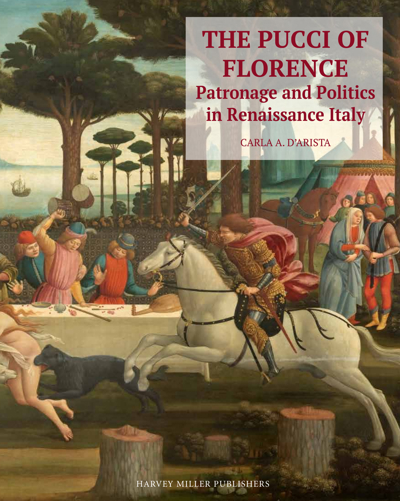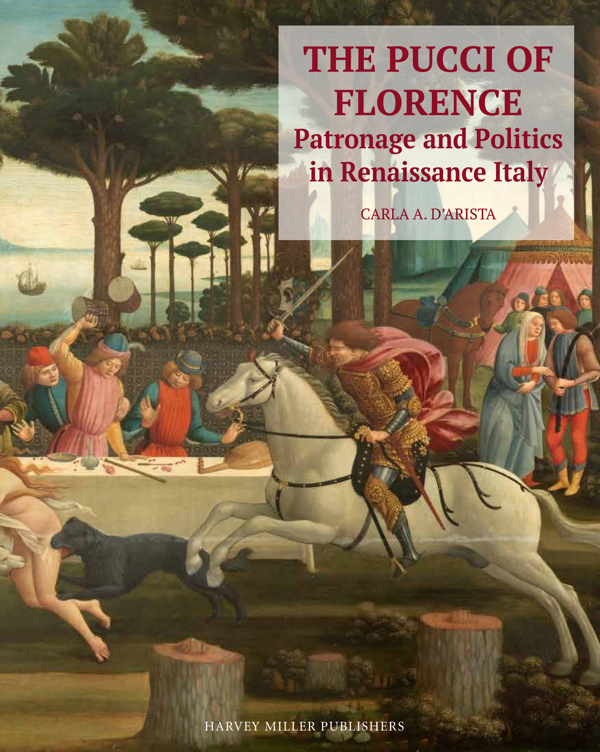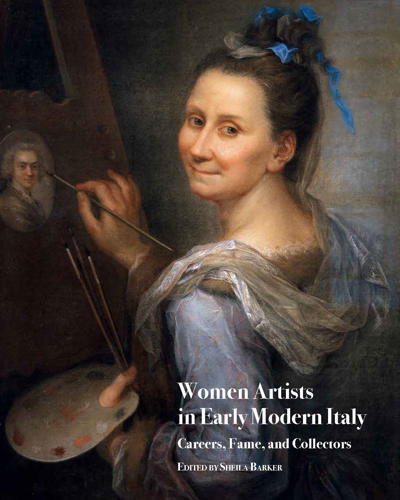
- Pages: iv + 359 p.
- Size:220 x 280 mm
- Illustrations:296 col.
- Language(s):English, Italian
- Publication Year:2020
- € 200,00 EXCL. VAT RETAIL PRICE
- ISBN: 978-1-912554-25-6
- Hardback
- Available
The story of the Pucci family, great patrons of Renaissance art and architecture.
“Carla D’Arista’s beautifully produced book on the Pucci family offers a gripping tale of architecture, art, and furnishings in the context of the political life of an elite Renaissance Florentine family (…) This ambitious, beautifully written and illustrated book is built on an impressive array of carefully interpreted archival sources.’ (Erin J. Campbell, in Architectural Histories, 9/1, 2021, p. 5-6)
« Ainsi, Carla d’Arista propose un ouvrage clair et richement illustré (…) cet ouvrage reste important par les sources qu’il traite et il offre une synthèse indispensable qui manquait jusqu’alors et qui pourra intéresser autant les historiens de l’art que les spécialistes d’histoire politique et diplomatique du Cinquecento. » (Clarisse Evrard, dans Histara, 23/09/2021)
“The most striking aspect of The Pucci of Florence. Patronage and Politics in Renaissance Italy is the sheer beauty of the production. On almost every page we have a superb image of some of the finest artistic products of the Italian Renaissance—buildings, sculptures, paintings and drawings, medallions, antiquities, articles of furniture, ornaments, and manuscripts—and for this achievement the publishers, Harvey Miller (part of Brepols), should be heartily congratulated. They have succeeded in giving an excellent idea of a period in which the serenity created by artists, and intended to teach lessons in civic conduct derived from the greatest classical models, must be seen against a backdrop of violence, wars, revolts, conspiracies, and executions in which the members of the Pucci family, both as victims and executioners, participated to the full. Ruthless in their pursuit of power and wealth, the Pucci proved their taste and discernment in their patronage of the arts.” (Alastair Hamilton, in Church History and Religious Culture, 101/4, 2021 p. 590)
“This book masterfully combines art and history to bring to life Renaissance Italy through the lives of the Pucci family (…) This is (…) a work that you would be proud to highlight to family and friends as one of your personal treasures. It offers us a precious jewel on the Renaissance life and times of the Pucci family.” (Michael A. Vaccari, in Renaissance Quarterly, LXXVI/3, 2023, p. 1126-28)
Carla D'Arista holds a PhD in architectural history and a masters degree in European history from Columbia University.
Shrewd and ruthless, the Pucci were Medici loyalists whose political and cultural alignment with the most powerful family in Renaissance Florence was rewarded with wealth and influence. The Pucci's martial support for the Medici in the dangerous business of ruling Tuscany drove their transformation from a clan of minor guildsmen to a noble dynasty with three cardinals to its name. Over the next two centuries, they showcased their exalted status with art and architecture that mirrored Medici tastes and reflected the values of civic humanism. The political and religious turmoil of the High Renaissance is writ large in this vivid portrait of the Pucci cardinals and their artistic patronage, a cultural biography inflected by the expulsion of the Medici from Florence, the Sack of Rome, the Reformation, and the occupation of Italy by Emperor Charles V.
New archival evidence documents the chapels, palaces, and villas that were built, expanded, and decorated by the Pucci family in Rome, Tuscany, and Umbria. These celebrated projects were carried out by luminaries of Renaissance art and architecture: Michelozzo, the Pollaiuolo brothers, the Sangallo family, Baccio d’Agnolo, the Montelupo workshop, and others. A remarkable body of inventories reveals how the family's trials and tribulations shaped the fate of their estates and illustrates the role luxury goods played in the social ambitions of this newly-arrived family. A previously unknown catalogue of Palazzo Pucci tells the tale of the nineteenth-century dispersal of the family’s priceless Renaissance artworks, a collection that once mirrored the splendor of the Medici court.
A note on Money and Currencies
A note on Weights and Measures
A note on Dates
A note on Spelling
Archival Sources Used in this Study
Family Tree
Introduction: ‘Beneath the Shadow of Thy Wings I Sleep’
I. From the Beginning: Medici Loyalists
II. The Pucci Oratory in Santissima Annunziata
III. Antonio Pucci: Dynastic Promotion and Image-Building
IV. Casa Pucci in Florence (1503-1537): Fashioning Social Hierarchies
V. Cardinal Lorenzo Pucci in the Eternal City
VI. Cardinal Antonio Pucci: A Scholarly Diplomat
VII. Roberto Pucci (1531-1547): It’s All in the Family
VIII. Reframing Ambition, Wealth, and Dishonor (1547-1612)
Epilogue (1612-1913)





